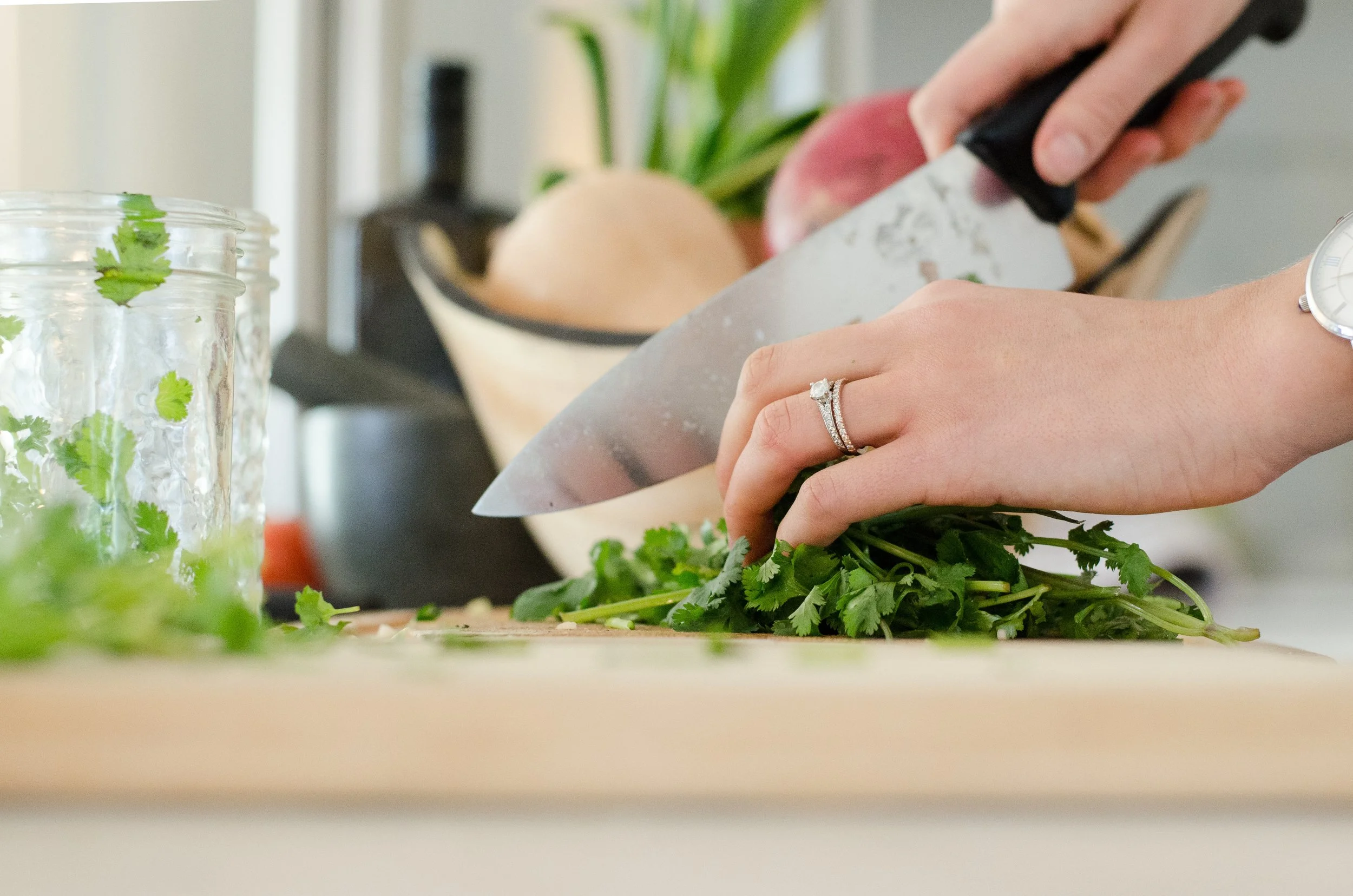Pathways to Well-Being through Cooking for Family and Friends
/photo by Alyson McPHee on unsplash
I find immense satisfaction, joy, and purpose in gathering the people I cherish around my dinner table. It allows me to foster deeper connections, embrace moments of happiness, and gain valuable insights from others. When I do the cooking myself, it takes my excitement to new heights!
Cooking has become one of my passions, sparked by an offer from my then-boyfriend, now husband, to pay for cooking lessons (Shanin later admitted his offer was motivated by his desire to marry someone who could cook well). Those classes ignited a deep love for culinary arts within me. As I delved deeper into the world of cooking, exploring food preparation techniques and the art of presenting dishes, my passion grew even stronger. By the time Shanin and I married in 1986, I had taken on the role of primary cook in our household, while he excelled as head cleaner. Together as newlyweds, we began hosting dinners and holiday events for both family and friends.
When Shanin and I started a family, we committed to having family dinners together most nights of the week. As our four daughters grew up, these dinners became an important ritual in our home. We did not realize it then, but research has since suggested shared meals can hold far-reaching benefits such as strengthening our relationships and cultivating protective factors against challenges like low self-esteem, depression and other forms of adversity (Neumark-Sztainer et al., 2010).
Cooking for my family became an additional avenue to manifest love, express creativity through developing recipes, and relieve stress, all at the same time. Knowing my family ate healthy meals boosted my confidence as a mom because I knew that people who eat healthy meals together are more likely to have healthy eating habits (Neumark-Sztainer et al., 2010). We further enriched our mealtime experiences by embracing rituals around our meals, such as baking challah (traditional Jewish bread eaten on holidays and celebrations) and playing games after dinner.
As our children grew older, family dinner emerged as the most important communication vehicle in our home. It was the one time of the day our family gathered in the same space to share both good news and challenges in our lives. These meals became a platform to discuss politics, moral dilemmas, and community news. We could be happy or sad, together fostering a sense of intimate attachment.
Family dinners provided us with an opportunity to value one another and to practice active constructive responding (ACR). ACR is a technique in which intentional supportive language and active listening skills are used to boost social bonds and resiliency (Gable et al., 2004). Dinners with extended family and friends have yielded similar benefits. The combination of food shared together has been the sauce that sparks meaningful conversation and deeper connection among those present.
Preparing holiday meals takes time and effort—from the shopping and menu planning to the cooking and table setting. The process can become anxiety-provoking and overwhelming. Approaching the preparation of these meals with a positive mindset can make a world of difference. When I cook Thanksgiving dinner, I think about the opportunity I am creating to strengthen social bonds with family and friends. I reflect on the gratitude I have toward myself for hosting the dinner. I embrace other positive emotions like pride and love, which research suggests contribute to a more positive mindset (Fredrickson, 1998; 2001; 2009).
Even people who don’t already find cooking intrinsically rewarding can get more joy out of it with a few quick tips. Here are some ideas for making cooking less stressful and more enjoyable, especially for large holiday meals:
Plan the menu well in advance. I find it saves time and energy in the decision-making process. I am not running out at the last minute to buy ingredients or looking through cookbooks frantically to find another recipe to make at the last minute. Laying out a strategy to plan a meal helps minimize the stress of each step in the process. Keep in mind that having goals that are attainable, specific, and challenging motivates high effort and builds skills, which Locke (1996) argues is important to building resilience and self-control.
Spread out the cooking over a number of days to lessen the stress of the cooking process. Making most of the menu items before the day of the dinner is ideal. Many food items, like desserts, can be kept frozen for weeks and still maintain taste if flash frozen and then tightly wrapped. Many recipes can be made 2 or 3 days in advance, especially soups or roasted vegetables. While you are planning your menu, include a few items that you can prepare ahead of time.
Ask each dinner guest to contribute a food item. This will lessen preparation time and allow guests to show gratitude toward you for their invitation. Asking others to bring food promotes an environment of giving and generosity that adds value to the evening. Giving to others promotes positive emotions and self-efficacy, an individual’s belief in their abilities to succeed (Grant, 2013). Another option is to host a potluck dinner party. Over the last thirty plus years, my guests have consistently reported feeling a deeper connection to our holiday dinner experiences when they contribute a dish, consistent with Adam Grant’s (2013) research findings.
Read through a recipe a few times so you are familiar with all the steps. Also, measure out each item in a recipe in advance. Then, there is no running around the kitchen trying to find an ingredient in the middle of making a recipe.
Consider framing cooking as an opportunity to be creative, mindful, and kind to others. Creativity in cooking and entertaining comes in many forms. You could set the table with holiday decorations to create a festive environment. You could try new ways of presenting food. You could create a buffet in which some food items sit on elevated serving pieces. You could use fresh herbs to decorate the top of a dish or substitute spices to make a recipe more to your liking. Creativity could also look like offering a question for each person at your dinner table to answer, such as, “What are you most grateful for over the past week?” This is a way to hear each person’s voice and encourage deeper bonding. Research suggests that being creative fosters self-confidence and new skills that can lead to personal growth (Golinkoff & Hirsh-Pasek, 2016).
Cooking for me is a way to enter into flow, and ease stress. Flow is complete engagement in an activity to the point of being fully immersed and losing conscious sense of space and time (Csikszentmihalyi, 2009). Flow produces a sense of achievement and profound association to an activity that has been shown to increase positive emotions and buffer against adversity (Nakamura & Ciskszentmihalyi, 2009). Chopping vegetables for me is an entry into flow. My mind becomes fully immersed into the present moment. I feel a rhythm of cutting through each vegetable with precision and joy. Time seems to fly by. I forget about any distractions or worries outside of my kitchen.
How can you enhance the experience of preparing a meal even if you’re not doing the cooking? Notice the colors and textures of the food on the plate before eating. Savor each bite. Savoring an experience can increase joy while decreasing negative emotions like stress (Lyubomirsky, 2007). Take your time eating. People who eat with more awareness and self-compassion are more likely to notice being full, and therefore less likely to overeat (Mantzios & Wilson, 2015). Being aware of our emotions creates greater self-understanding (Waters, 2017).
If you taste a dish particularly delicious, ask for the recipe. You will be happy to gain the recipe, and the person you ask will likely enjoy the compliment.
Whether you are cooking or enjoying food made by others, be mindful of opportunities to enjoy the experience more intentionally.
Please consider making some or all of the following recipes. They will be included in my upcoming cookbook called, Jewish Cooking and Pathways to Well-Being.
For more information on the value of family meals, flow, and other topics mentioned is this article, please read my capstone from the University of Pennsylvania Master of Applied Positive Psychology (MAPP) program, Positive Shabbat Dinner: An Effective Positive Intervention to Increase Well-being.
References
Csikszentmihalyi, M. (1990). Flow: The psychology of optimal experience. Harper & Row.
Farmer, N. & Cotter, E. (2021). Well-being and cooking behavior: Using the positive emotion, engagement, relationships, meaning, and accomplishment (PERMA) model as a theoretical framework. Frontiers in Psychology, 12. https//doi.org/10.3389/fpsyg.2021.560578
Fredrickson, B. L. (1998). What good are positive emotions? Review of General Psychology, 2, 300–319.
Fredrickson, B. L. (2001). The role of positive emotions in positive psychology: The broaden-and-build-theory of positive emotions. American Psychologist, 56, 218–226.
Fredrickson, B. L. (2009). Positivity. Three Rivers Press.
Grant, A. (2013). Give and take: A revolutionary approach to success. Penguin Books.
Gable, S. L., Reis, H. T., Impett, E. A., & Asher, E. R. (2004). What Do You Do When Things Go Right? The Intrapersonal and Interpersonal Benefits of Sharing Positive Events. Journal of Personality and Social Psychology, 87(2), 228–245. https://doi.org/10.1037/0022-3514.87.2.228
Golinkoff, R. M., & Hirsh-Pasek, K. (2016). Becoming brilliant: What science tells us about raising successful children. APA Life
Locke, E. A., (1996). Motivation through conscious goal-setting. Applied & Preventive Psychology, 5, 117–124. Cambridge University Press.
Lyubomirsky, S. (2007). The how of happiness: A new approach to getting the life you want. Penguin Books.
Mantzios, M., & Wilson, J.C. (2015). Mindfulness, eating behaviors, and obesity: A review and reflection on current findings. National Library of Medicine. Retrieved from https://pubmed.ncbi.nlm.nih.gov/26627097/.
Nakamura, J., & Csikszentmihalyi, M. (2009). Flow theory research. In S. J. Lopez & C. R. Snyder, & (Eds.), Handbook of Positive Psychology (pp. 195–206). Oxford University Press.
Neumark-Sztainer, D., Larson, N., Fulkerson, J., Eisenberg, M., & Story, M. (2010). Family meals and adolescents: What have we learned from Project EAT (Eating Among Teens)? Public Health Nutrition, 13(7), 1113–1121. https//doi.org/10.1017/S1368980010000169
Waters, L. (2017). The strength switch: How the new science of strength-based parenting can help your child and your teen to flourish. Penguin Random House.
About the author | Tracey Specter (C’18) is a certified executive coach who works with nonprofit professionals. Tracey sits on a number of nonprofit boards, including being the Chair of the Board of the Share Food Program in Philadelphia, which is one of the largest food banks in the United States. Tracey and her husband have four daughters, a son-in-law, a son-in-law-to-be, and a dog named J. Besides cooking and entertaining, Tracey is a triathlete, a yogi, and an avid hiker.
To keep in touch, reach out to me at tracey@tspecter.com.







